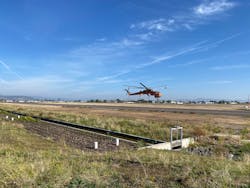Airport Business 2023 Project of the Year: Rogue Valley International – Medford Airport Stormwater Treatment Facility
A new stormwater treatment facility at Rogue Valley International – Medford Airport (MFR) increases stormwater management on impervious airport surface areas by collecting stormwater from 139 acres of existing impervious surfaces and 35 acres of planned improvements.
Jackson County Airport Authority in Oregon was faced with meeting municipal requirements, which require collecting and filtering pollutants found in stormwater runoff from new pavement and hangar improvements. The planned developments over the next 5 years include these 35 acres of new impervious surfaces.
Local standards only require stormwater treatment for newly constructed impervious surfaces.
“The airport felt that it was important to go above what was minimally required. Preventing possible pollutants generated from airport-related activities from leaving airport property was our goal, as this enhances the eco system of the Rogue River. We also did not want to be short-sighted. For a small amount of additional construction costs, now we are able to check the stormwater box for future projects at MFR. This will save us time and money in the future,” said Amber Judd, interim airport director.
The stormwater treatment system for Basin 4, completed in 2022, minimizes the number of individual areas by creating one high-capacity and centralized facility. The benefits are maintenance activities can focus efforts in one location and areas that would otherwise be occupied by smaller detention ponds can be developed with airport infrastructure.
Dave Butler of Precision Approach Engineering, Inc. said the system works like this: A flume fills with water, overtops and filters down through four filtration basins that are each about 100 feet long, 15 feet wide. Next, a manifold system underneath conveys the water to a storm drain system of about 1,000 feet that runs it down to a detention area that in most years would not see water. This area is designed for a 25-year event (3.25 inches of water in 24 hours). When the detention area backs up, it’s designed to empty within 48 hours. To help the stormwater drain out within 48 hours of a 25-year event, Josh Lekkerkerker, PE, Precision Approach Engineering, said there’s a concrete valley gutter along the floor of the pond. Interior pond walls are lined with crushed aggregate or large riprap-type rock to deter waterfowl.
After a 2-year storm, local code states the stormwater facility should be designed to treat 1 inch of rainfall in a 24-hour period, however this project treats 1.17 inches in a 24-hour period.
Traditionally stormwater treatment is achieved by slow-flowing runoff through surface vegetation, but this results in a large footprint of standing water that tends to attract wildlife.
The MFR project includes newer stormwater treatment materials from Oldcastle Infrastructure. The BioPod Boxless Biofiltration System incorporates a high-flow media, which allowed project engineers to design a system to filtrate high flows of runoff underground.
Secondly, by implementing StormMix Media, the runoff is treated through a vertical column of media, collected in an underground network of pipes and discharges directly to the airport outfall point. The capacity of this system gets a high volume of water off the surface, filters it and gets it back to the stream in a controlled flow. StormMix removes a variety of compounds from stormwater runoff: pollutants, suspended solids, dissolved metals, nutrients, gross solids, trash/debris and petroleum hydrocarbons that accumulate on paved surfaces.
Filtered water from Basin 4 outlets via a drainage ditch into Upton Creek at the north end of the airport. After approximately 6 miles, Upton Creek connects to the Rogue River.
Location: Rogue Valley International – Medford Airport
Project: Stormwater Treatment Facility
Completion: June 2022
Key Participants: Precision Approach Engineering, Inc; Knife River Materials
Category: Environmental
Cost: About $4M
